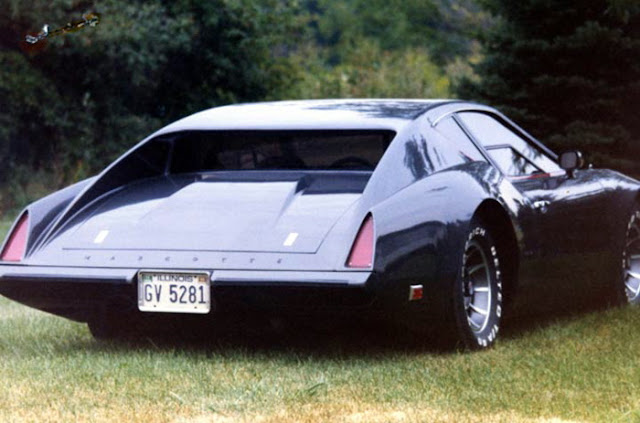The story of the Fugitive 2 begins in 1981. Alan Arnold, who had built cars and motorcycles as a hobbyist from the age of 16, decided in to start his own specialist car and parts business. After spending 18 months researching US companies whose products interested him, he managed to get distribution agreements with a number of them. The Unique Vehicle & Accessory Company (UVA) was launched from the double garage attached to his house in Curridge, a village near Newbury in Berkshire UK.
The initial product range was the Beetle based Manta Cars Montage kit car which eventually morphed into the M6GTR and a range of VW performance parts from Bugpack and Sway-Away. He added to this range of Beetle performance parts by importing engine to VW transmission adaptor kits from Kennedy Engineering. Comprehensively producing a range of products that both sold individually to go-faster VW owners and kit car builders in the market for something exotic.
 |
| The Fugitive 2 in "street" form |
The Fugitive 2 was originally a Baja sand-rail chassis regularly imported from the USA. After further development, it was launched in 1984 and featured in Street Machine magazine in their September issue.
Such off-road and recreational vehicles were a growing segment in the UK kit industry of of the 80's. The success of Birmingham based Kingfisher Kustoms, demonstrated to Arnold that there was a market for road legal Fugitives. So, UVA entered this market as well, not just producing Baja style Fugitives, but selling a lowered version for street use as well.
The "street" version of the Fugitive recalled the Lotus 7, if those were rear-engine. Its long nose and cycle fenders added to the impression. In this configuration, it competed very successfully in the 750 Motor Club kit-car race series. The Fugitive 2 range also spawned a 2+2 model called, not unsurprisingly, the Fugitive 4.
 |
| The Fugitive 2, in its natural habitat |
The kit was designed to utilize parts from a VW Beetle. Any of the 1200, 1300, 1500, and 1600 models could be used. The donor parts included the VW front and rear suspension, steering, engine, transmission, electrics, and fuel tank. UVA also supplied other suitable parts such as purpose made fuel tanks and adaptors to allow the use of other engines.
Hard tops, full screens and removable doors were also produced. By late 1985 UVA had a larger spread of designs available. The Fugitive was available in many forms both 2 and 4 seater. The Fugitive 3 series, which was aimed more at racing than off-roading, was also available.
 |
| The Fugitive 2 was almost "Seven-esque" in road legal form |
In 1986 Arnold was approached by a TV producer to start a new UK off-road race series called BORRA (British Off Road Racing Association). As a result of this, UVA developed a more competition oriented, single-seat version of the Fugitive which ultimately sold well. However, investor money failed to materialize for the venture. This would prove a sign of things to come.
By 1990 UVA, having pared down its range, relied mainly on the Fugitive 2 & 4 series cars and its F33 Can-Am. The F33 was an interesting beast, based on the Fugitive 4 frame sans rear seats. UVA reversed the gearbox, giving it a mid-engine layout. The frame was certainly strong enough to take more power, so they dropped in a Rover V8 cooled by side-mounted radiators (from a VW Golf), fed by intakes cribbed from the Ferrari Testarossa. With lowered suspension, enclosed wheels, and pop up headlights it lost all pretenses of off-road ability.
 |
| The Fugitive F33 Can-Am was absolutely batshit crazy |
The company continued to enjoy positive coverage in the press. However dark days loomed on the horizon. With the world moving into a financial melt-down, people no longer wanted to risk their hard-earned cash on performance cars and parts. In 1991, 10 years after it started, UVA went into liquidation.
After a bit of a rough patch in the mid 90's, Alan Arnold became a pioneering promoter of Online Search and eCommerce services. This led to a career in consulting at the turn of the century. By 2010, he was planning to retire and cruise the inland waterways of mainland Europe aboard a replica "Dutch Klipper" sailboat.
 |
| The Fugitive F33 Can-Am in profile |
 |
The Fugitive F33 Can-Am had a claimed 150mph
top speed and 4 second 0-60 time. |
 |
| The Fugitive F33 Can-Am interior |
 |
| The Fugitive F33 Can-Am had very a spartan cockpit |
 |
| The Fugitive 2 |
 |
| This Fugitive appears to have an intermediate ride-height |
 |
| The Fugitive 2 chassis |
 |
| The Fugitive 2, after a romp in the mud |
 |
| The Fugitive 4, showing its space for back seats |
 |
| The Fugitive 4 |
 |
| This Fugitive 2, looks ready for the apocalypse |
 |
| The Fugitive sans bodywork |
 |
| The Fugitive 2, shown with particularly gutsy tires |
 |
| UVA Fugitive 2 with a Rover V8 |
 |
| UVA Fugitive 2 with a 2000cc DOHC 1978 Lancia Beta engine |
 |
| UVA Fugitive 2, at rear, showing its Rover V8 |
 |
| UVA Fugitive 2 interior, in off-road guise |


























Comments
Post a Comment